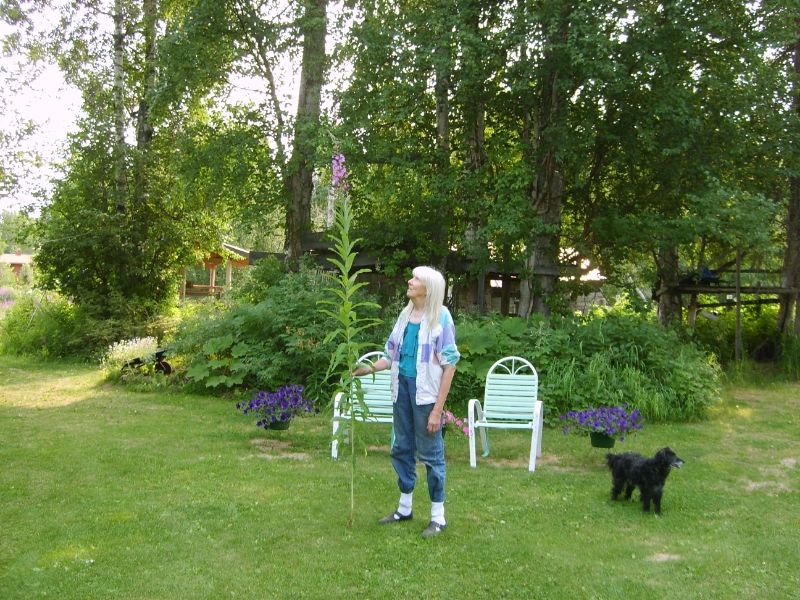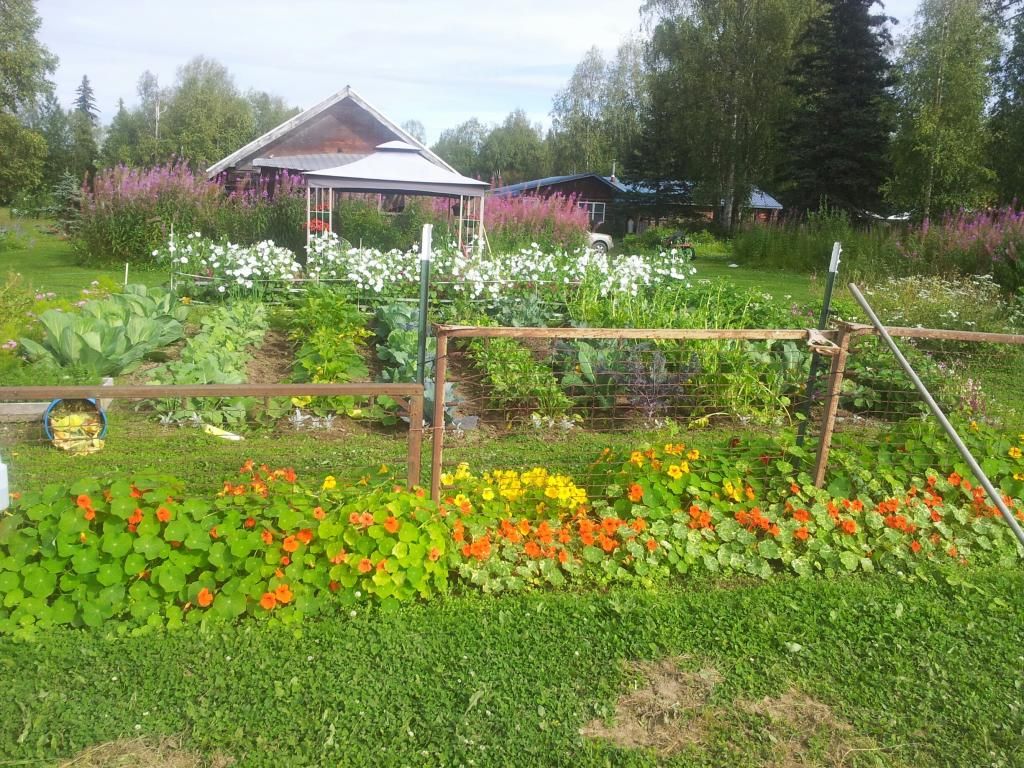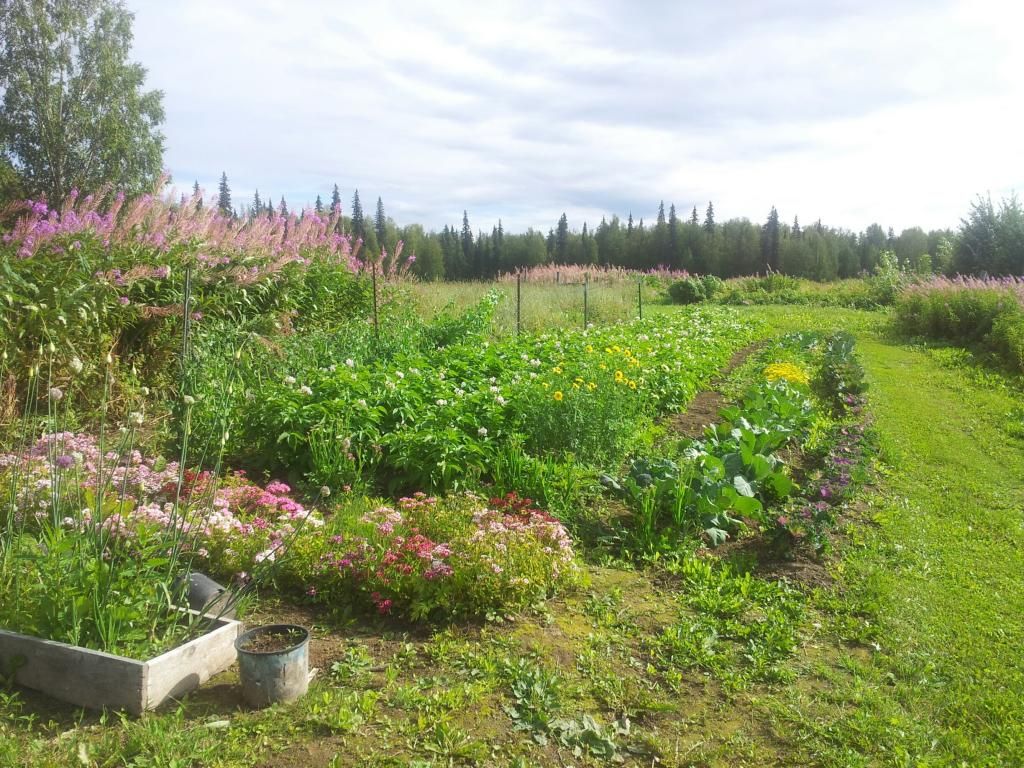One of my favorite wild flowers is fireweed (
Chamerion angustifolium).
The scientific name Chamerion angustifolium is actually fairly recent, and in many sources it is still named
Epilobium angustifolium or
Chamaenerion angustifolium.
Some other common names are willow herb, great willow-herb, spiked willow-herb, rosebay willow-herb, purple rocket and bombweed.
It is not to be confused with
Senecio madagascariensis, a poisonous plant also commonly called fireweed.
Fireweed is
native to much of the planet. It can live in a wide variety of conditions, but likes moist, acidic soil and plenty of sun.
It is most often found on disturbed sites, especially areas that have recently been burned. It produces a large amount of seed that can travel long distances, and it is known for rapidly colonizing areas with exposed mineral soil. It doesn't normally establish itself from seed in places where the soil is not exposed. It mainly spreads vegetatively by rhizomes, which can spread very quickly. “A 4-year-old rhizome was excavated and found to be 20 feet (6.1 m) long; it had 56 perennating buds.”
http://www.fs.fed.us/database/feis/plants/forb/chaang/all.html Fireweed send up very fast growing shoots. The ones where I live are usually 5-6 feet tall. In poor conditions they are often only 3-4 feet tall. In good conditions I've seen them get almost ten feet tall! They form dense stands which can shade out most everything trying to grow beneath them. The only thing I've seen growing with any success amongst a dense stand of fireweed is cow parsnip (
Heracleum maximum).
This is my grandmother holding a fireweed stem. I'd say she's just short of six feet tall.

Fireweed is most commonly appreciated for its beauty, but it also has many uses.
It is a very useful plant for
bees. A lot of
honey in Alaska is branded as fireweed honey. I think it tastes good, but I think pretty much all honey tastes good. It has a lot of flowers and is in bloom for quite a long time. It is also supposed to attract hummingbirds and butterflies.
The petals can be made into jelly. A lady in my hometown made her living selling fireweed jelly.
The young shoots can be peeled and eaten raw or cooked. I've heard it compared to asparagus, but I haven't tried it myself. When the shoots get older they can be split open and the pith can be eaten.
The leaves can be used to make tea. The
roots can be dug up and eaten (they are supposed to be best in the spring). I haven't tried either the tea or the roots myself.
From what I've read no part of the plant is poisonous, and it generally sounds like it is best in the spring and early summer. I have read one reference to the tea being “stupefying” on PFAF. (Have you ever noticed how everything on PFAF is listed as potentially poisonous?) I have read a couple times that one
medicinal use is as a laxative, so be careful and definitely do your own research before eating it!
It has many listed medicinal uses. I'm not very knowledgeable about medicinal herbs, and it is hard to keep all the different uses I've read for it straight, so I'm not going to try to list all of them. The most common seemed to be as a treatment for sunburn and other skin irritation, a treatment for prostate problems and a remedy for upset stomach.
The skin can be peeled and used for cordage. It is easy to pull very long strands off of the plant.
One use I'm very much interested in is animal
feed. From what I've read, it is only fair forage for livestock. On the other hand many wild ungulates eat a lot of it, especially in the northwestern United States. “In the Rocky Mountains, fireweed is an important food for elk in summer... [e]lk sometimes feed exclusively on fireweed.”
http://www.fs.fed.us/database/feis/plants/forb/chaang/all.html.
From my personal
experience, goats love fireweed. It is tied with raspberries for our goats' favorite thing to eat (excluding treats like grain and table scraps). Back when we used to
milk one of our goats, I never noticed any weird flavors in the milk.
Here is a little bit about protein content:
”U.S. Forest Service” wrote:Nutritional value of fireweed varies depending on season and site. Fireweed crude protein averaged 20 percent throughout the second summer following fire; dry matter digestibility was over 80 percent. In another study, crude protein content was 13.7 percent, and protein digestibility (dry matter) was 13 percent. Fireweed collected in July in Alaska had 11.9 percent protein, 62.2 percent dry matter digestibility for moose, and 64.7 percent dry matter digestibility for dairy cow. Fireweed samples taken in July and August in Minnesota had crude protein of 4 to 9 percent and dry matter digestibility of 28 to 69 percent. In Oregon, June fireweed foliage had 17.7 percent protein.
Fireweed flowers contain tannins that have a very high capacity to precipitate proteins, reducing the actual amount of protein available to an herbivore.
http://www.fs.fed.us/database/feis/plants/forb/chaang/all.html
The B.C. Ministry of Agriculture writes that fireweed is “[f]air to good forage for sheep, poor to fair forage for
cattle. This plant is sometimes grazed by horses,
deer, and elk. Forage quality decreases as the plant matures.”
http://www.agf.gov.bc.ca/range/RangeID/Plants/EpilAngu.html
Another tidbit I came across: “Rosebay willowherb has been believed in Finland to increase the milk production in cattle, and was thus often added to feed.”
http://www.luontoportti.com/suomi/en/kukkakasvit/rosebay-willowherb
Fireweed that grows after a fire might be more nutritious: “Fireweed effectively uptakes and recycles large amounts of nutrients from burned-over areas. Fireweed foliage had significantly (p<0.05) higher levels of nutrients (potassium, magnesium, manganese, phosphates, and zinc) on burned areas compared to unburned controls.”
http://www.fs.fed.us/database/feis/plants/forb/chaang/all.html
One reason that I'm interest in it as animal feed is that it grows very easily and takes care of itself. It borders many of the buildings and
trees around my grandparent's homestead. It's been growing there for decades without any maintenance,
water or fertilizer.
Another reason is that it just provides so much fast growing biomass. They grow six feet in a season, produce a lot of leaves and grow very close together.
I've read a little about people planting pieces of rhizomes to propagate fireweed. That is probably the safest way to do it. If there is plenty of fireweed in the area, a faster method might be controlled burns (under appropriate conditions, with proper precautions, obeying
local laws, etc.). I've also read that damaging the roots can stimulate shoot growth.
They are very easy to pull by hand. They pop out of the rhizomes like a rhubarb stock pops out of its
root. A person can gather an armful very quickly. On a large scale a scythe or machinery would still be faster.
We've done some very small experimentation with trying to store fireweed as
hay. These were very half-assed.
The first time I suggested it as a possibility most of my family members thought it was to thick to dry. In mid-summer I pulled three shoots before the flowers had opened up. I broke off the flower and root on all of them. One I broke into sections, one I laid on a board and crushed with my foot, and the other I left intact. I put these under a lean-to on the side of our barn. I checked on them at Christmas, none of them looked rotten and they all looked green. I wanted to check again late winter but the goats found them and ate all of them. A good sign?
My brother piled a bunch on a couple
pallets in our hay barn. This was after the flowers had opened up, but before they had gone to seed. The pile wasn't very deep, maybe four inches. In late May of the next year they still looked good. I took some to our goats, who sucked all the leaves off of them but didn't eat the stems. I'm guessing this was because there was fresh greenery at the time, so dried up old stems weren't very appealing. I'd like to try it again in the winter to see if they are inclined to eat all of it. The shoots he picked were also more mature, so they might have been less palatable.
I want to do more experiments to see if I can get a bigger pile to store without rotting. I don't know that fireweed would ever make a good commercial crop, but it might be good for a big homestead or small farm. The size where people need a good amount of animal feed, but a
tractor, mower and bailer are too expensive.
I've read somewhere that fireweed was a good winter browse for animals because it is tall and stands above the snow line. I can't seem to find the place that I read that. The fireweed around here mostly gets crushed flat by the snow. We gets lots of wet, heavy snow so it might do better in other places. There are still plenty of stems standing in the spring, but they are mostly broken off at 2-4 feet, which would be under the snow.
Fireweed leaves behind a large amount of straw. It is easy to rake it up in the spring. I've also collected it from among younger shoots with a hay fork without doing much damage to them. This has all gone on our half-assed
compost heap, but it might also be useful for bedding or mulch.
It might also be good as a decorative firebreak around buildings. “Fireweed has high
ash and high moisture content; it is not considered flammable.”
http://www.fs.fed.us/database/feis/plants/forb/chaang/all.html It would also shade the walls of the structures. The straw might be a fire hazard, but it could be removed in the spring or the shoots could be cut and removed in early winter.
I've read some places that fireweed can be a problematic weed. In my experience it hasn't been a problem in our gardens. I've seen how fast it springs up after fires, but even after tilling it just doesn't seem to show up in our garden beds. It does spread out pretty quickly through its rhizomes, but infrequent mowing seems like
enough to keep it in check. I can see how it might pose a problem to people trying to establish slow-growing perennials on a large scale with little or no maintenance (like government foresters after a forest fire).
I had a bunch of pictures of the fireweed around my grandparent's homestead, but unfortunately I seem to have lost them.
Here's a couple garden pics that have some firweed in the background.

 Sources
Sources
Pavek, Diane S. 1992. Chamerion angustifolium. In: Fire Effects Information System, [
Online].
U.S. Department of Agriculture, Forest Service, Rocky Mountain Research Station,
Fire Sciences Laboratory (Producer).
http://www.fs.fed.us/database/feis/plants/forb/chaang/all.html
(I cited this one all fancy because I pulled the most direct quotes from it. Also they included the citation, making it easy.)
B.C. Ministry of Agriculture
http://www.agf.gov.bc.ca/range/RangeID/Plants/EpilAngu.html
Agriculture and Agri-Food Canada
http://www.agr.gc.ca/eng/science-and-innovation/science-publications-and-resources/resources/canadian-medicinal-crops/medicinal-crops/chamerion-angustifolium-l-holub-fireweed/?id=1300903819413
Wikipedia
http://en.wikipedia.org/wiki/Chamerion_angustifolium
NatureGate
http://www.luontoportti.com/suomi/en/kukkakasvit/rosebay-willowherb
Plants for a Future
http://www.pfaf.org/user/plant.aspx?LatinName=Epilobium+angustifolium
Montana Plant Life
http://montana.plant-life.org/species/epilob_angus.htm

 1
1




















